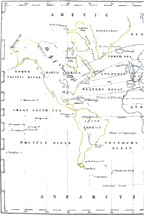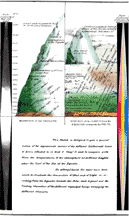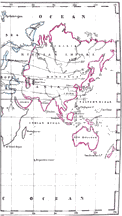INTRODUCTION.
OF THE LEADING ARGUMENT OF NATURAL
THEOLOGY; THAT DESIGN, OR THE ADAPTATION OF MEANS TO AN END EXISTS IN
NATURE.
001
002
003
004
005
006
007
008
009
BOOK I.
OF CHEMISTRY:
CHAPTER I. OF THE MUTUAL
OPERATION OF PHYSICAL AGENTS AND OF MATTER,
AND OF THE LAWS WHICH THEY OBEY.
024
025
026
027
CHAPTER II. OF THE INERTIA AND ACTIVITY OF MATTER.
027 028
029
030
031
CHAPTER III. OF MOLECULAR OR POLARIZING FORCES, ETC.
031
SECTION I. Of the Divisibility of Matter
032
033
034
035
036
SECTION II. Of the Forms
of Aggregation of the ultimate Molecules of Matter
036
037
038
SECTION Ill. Of the solid Form of Bodies. crystallization
038
039
040
041
042
043
044
045
046
047
048
049
050
051
052
053
054
055
056
057
Of' Electricity 45
Of Galvanism 47
Of Magnetism
48
Of Polarity 53
SECTION IV. Of the Liquid Form of Bodies.
057
058
059
060
061
062
063
064
065
066
067
Of Heat 57
Of the Effects of Heat 60
Of the Latency of Heat 61
SECTION V. Of the Gaseous Form of Bodies
067
068 069
070
071
072
073 074
075
076
077
Of the Diffusion of
Gaseous Bodies 72
Of the Equal Expansion of Gaseous Bodies; and
of their similar Capacity for Heat 74
SECTION VI. Of the other Properties of Heat.
077
078
079
080
081
082
Of Heat in Motion.
Of the
Radiation, Conduction, and Convection of Heat 77
SECTION VII. Of Light
082 083
084
085
086
087
088
089
090
091
092
Of the Radiation of Light 82
Of the Reflection and Refraction of
Light 84
Of the Polarization of Light 85
Of the
Decomposition of Light 89
SECTION VIII. Of the Sources of Heat and
Light
092
093
094 095
SECTION IX. Recapitulation and General Observations on the Subjects
treated of in the preceding Chapters
095
096
097
098
099
100
101
102
103
104
105
Arguments in Proof of
Design, deducible from the Divisibility and
Molecular Constitution of Matter 98
CHAPTER IV. OF CHEMICAL
ELEMENTARY PRINCIPLES, AND OF THE LAWS OF THEIR
COMBINATION.
105
SECTION I. Of Chemical Elementary Principles
106
107
108
109
110
111
112
113
114
115 116
117
118
119 120
121
122
123
124
125
126
127 128
129
130
131
132
133
134
135
136
Of the Supporters of Combustion;
Oxygen, Chlorine, Bromine, Iodine, and Fluorine 109
Of the Acidfiable Bases; Hydrogen, Carbon, Azote, Boron, Silicon,
Phosphorus, Sulfur; Selenium, Arsenic, Antimony, Tellurium, Chromium,
Uranium, Vanadium, Molybdaenum, Tungsten, Titaniun, and Columbium
114
Of the Alkalifiable Bases 124
Of
the Alkaline Bases; Potassium, Sodium, Lithium, Calcium, Magnesium,
Strontium, and Barum 124
Of the Earthy Bases; Aluminum, Glucinum, Yttrium, Zirconium, Thorinum,
and Cerium 129
Of the Difficultly Fusible Bases; Iron, Manganese,
Nickel, and Cobalt 130
Of the Easily Fusible Bases; Zinc,
Cadmium, Lead, Tin, Bismuth, Copper, and Mercury 132
Of the Noble
Metals; Silver, Gold, Platinum, Palladium, Rhodium, Iridium, and
Osmium 135
SECTION II. General Remarks upon Chemical Compounds.
136
137
138
139
140
141
142
143
144
Of PRIMARY COMPOUNDS 136
Of Acids 137
Of Alkalies and Bases 140
Of Neutral Compounds 141
Of SECONDARY COMPOUNDS; SALTS 142
SECTION III. Of the Laws of Chemical Combination.
144
145
146
147
148
149
150
151
152
153
154
155
156
157
158
159
160
161
162
163
Of the ATOMIC THEORY 156
Of the Representation of the Combining Molecules of Bodies by Numerical
Series 161
SECTION IV. Recapitulation. General Reflections on the Subjects treated
of in the last Section of the
preceding Chapter
163
164
165
166
167
168 169
170
171
172
173 174
175
176
177
178
179
180
181
182 183
184
185
186
187
188
Statement of the Facts on which the
Atomic Theory isFounded 163
Of the Adaptation of Subordinate to Primordial Agents and Elements, and
of the Means by which these Adaptations have been effected 165
Of Adaptations produced by Adjustments of Quality and Quantity 170
Of the Tendency in Nature to a State of Repose or Equilibrium 176
Of the Creation of the Elements with the Properties essential to
produce perfect Compounds 182
Of the Wonderful Nature of the most Simple Chemical Processes.
Conclusion 185
BOOK II.
OF METEOROLOGY:
COMPREHENDING A GENERAL SKETCH OF THE
CONSTITUTION OF THE GLOBE; AND OF
THE DISTRIBUTION AND MUTUAL INFLUENCE OF THE AGENTS AND ELEMENTS OF
CHEMISTRY IN THE ECONOMY OF NATURE.
PRELIMINARY OBSERVATIONS
188
189
190
191
CHAPTER I. OF THE GENERAL STRUCTURE OF THE EARTH; PARTICULARLY WITH
REFERENCE TO THE DISTRIBUTION OF ITS SURFACE INTO LAND AND WATER; AND
WITH RESPECT TO ITS ATMOSPHERE.
191
192
193
194 195
196
197
198
199
200
201
202
203
204
205
SECTION 1. Of the General Relations of
the Sea and Land to each other 191
SECTION II.Of the Ocean 193
SECTION III.
Of the Atmosphere 197
CHAPTER II. OF HEAT AND LIGHT: THE MODES OF ESTIMATING THEIR DEGREE,
AND THE WAYS IN WHICH THEY ARE PROPAGATED. OF THE GENERAL TEMPERATURE
OF THE CELESTIAL REGIONS, AND OF THE EARTH INDEPENDENTLY OF THE SUN 205
SECTION 1. Of Heat and Light, and the Modes of estimating their
Degree
205
206
207
208
209
210
211
212
213
214
215
SECTION II. Of the Propagation of Heat and Light 207
SECTION III. of the Temperature of the Celestial Regions 209
SECTION IV. Of the Temperature of the Interior of the Earth 210
CHAPTER III. OF THE TEMPERATURE OF
THE EARTH AT ITS SURFACE, AS DEPENDENT ON THE SUN
215 216
217
218
219 220
221
222
223
224
225
226
227 228
229
230
SECTION I. Of Mean
Temperature 217
SECTION II. Of the actual Distribution
of
Temperature over the Globe Of Isothermal Lines, &c. CLIMATE
219
Of the Temperature of the Poles and of the Polar Regions 219
Of the mean annual Temperature of the Equator 221
Of the Temperature of the intermediate Regions of the Globe. Of
Isothermal Lines, &c. 222
CLIMATE 229
CHAPTER IV. OF THE
PRIMARY CONSTITUENTS OF CLIMATE: OR OF THE TEMPERATURE OF THE EARTH, AS
DEPENDENT ON ITS GLOBULAR FORM; AND ON ITS ANNUAL AND DIURNAL
MOTIONS
230
231
232
233
234
CHAPTER V. OF THE SECONDARY OR SUBSIDIARY CONSTITUENTS OF CLIMATE;
COMPREHENDING A SKETCH OF THOSE CIRCUMSTANCES CAPABLE OF INFLUENCING
CLIMATE, WHICH ARE MORE IMMEDIATELY CONNECTED WITH THE SURFACE OF THE
EARTH, AS CONSISTING OF LAND OR WATER; OR WHICH ARE CONNECTED WITH THE
ATMOSPHERE.
234
235
1. Of the Proportion of Solar Beat and
Light that actually arrives at
the Surface of the Earth 236
2. Of the Distribution of Heat and Light over the Earth's Surface in
the latent Form 238
3. Of the General Distribution of Electricity and Magnetism over the
Earth 239
4. Of the Distribution of Light in the decomposed Form over the .Earth
243
5. Of the Laws of Absorption, Radiation, and Reflection of Heat and
Light 246
6. Of the Conduction of Heat below the Earth's Surface on Land 252
7. Of the Propagation of Heat and Light below the Earth's Surface in
Water 255
Of the Temperature of the Waters of the
Ocean at great Depths 261
Of the under Currents of the Ocean existing between the Equatorial and
the Polar Regions 263
8. Of the Differences of Temperature as depending upon whether the
Surface be Land or Sea. 264
Temperature of Natural Springs
266
SECTION II. Of the secondary
Constituents of Climate immediately connected with the Atmosphere
268
1. Of the Distribution of Heat and of
Light through the Atmosphere,
and of the Consequences
268 269 270
271
272
273 274
275
276
277
278
279
280
281
282 283
Of the Limits of Perpetual Snow
272
Of the Distribution of Heat and Light through the Atmosphere in their
Latent Forms 275
Of the Propagation of Sensible Heat through the Atmosphere 275
Of Atmospheric Currents. The Trade Winds 276
2. Of the Presence of Water in the Atmosphere
283
284
285
286
287
288
289
290
291
292
293
294 295
296
297
298
299
300
301
302
303
304
305
306
307
308
309
310
311
312
313
314
315 316
317
318
319 320
321
322
323
324
325
326
327 328
329
330
331
332
333
334
335
336
337
338
339
340
341
342
343
344
345
346
347
Of the Phenomena of Evaporation and
Condensation; and of the General
Dependance ofVapour onTemperature 284
Of the Conditions of an
Atmosphere of Vapour alone; and of a Mixed Atmosphere of Vapour and
Air 288
Of the General Relations of Evaporation and Condensation
as they exist in our Atmosphere; and of the Circumstances by which
these Relations are Influenced 299
Of the Accidental Circumstances affecting Evaporation 305
Of the
Accidental Circumstances affecting Condensation 309
Of Dew and
Hoar Frost 309
Of Mists and Fogs 312
Of Clouds 315
Of Snow andSleet 322
Of Rain 324
Of Hail 331
Of the actual Quantity of Water that is evaporated and condensed over
the Globe 333
Of the Distribution of Heat and Light in their latent and decomposed
forms through the Vapour of the Atmosphere; and of the Effects of that
Distribution 339
Of the Relations of Electricity
to the Vapour of the Atmosphere 339
Of the Aurora Borealis 343
Of
the Phenomena depending upon the Decomposition, Refraction, and
Reflection of Light by the Vapour of the Atmosphere. The Mirage. The
Fata Morgana. Halos. The Rainbow 343
3. Of the Occasional Presence of Foreign Bodies in the Atmosphere; and
of their Effects 347
Of Matter suspended in the Atmosphere
in a state of Mixture. Coloured
Rain and Snow. Aerolites. Dry Fogs
347
348
349
350
351
352
353
354
355
356
357
358
359
360
361
362
363
364
365
Of Matters which pervade the Atmosphere in a state of Solution.
Malaria 353
Recapitulation. The Arrangements
of Climate demonstrative of Design 356
CHAPTER VI. OF THE ADAPTATION OF ORGANIZED BEINGS TO CLIMATE;
COMPREHENDING A GENERAL SKETCH OF TIlE DISTRIBUTION OF PLANTS AND
ANIMALS OVER THE EARTH, AND OF THE PRESENT POSITION AND FUTURE
PROSPECTS OF MAN
365
366
367
368 369
370
371
372
373 374
375
376
377
378
379
380
381
382 383
384
385
386
387
388
389
390
391
392
393
394 395
396
397
398
399
400
401
402
403
404
405
406
407
408
409
410
411
412
413
414
415 416
Of the Formation and Ingredients of the
SOIL .. 366
SECTION I. Of the Distribution of
Plants over the Earth 368
1. Of the Differences of Vegetation, as
liable to be influenced by Soil, and by other minor Local
Circumstances, in the same Climate 368
2. Of the Influence of Climate on Vegetation. Distribution of
Plants 372
Profusion of Vegetable
Productions 379
SECTION II. Of the Distribution of
Animals over the Earth 383
1. Of the Differences existing among
Animals in similar Climates 386
2. Of the Effects of Diversity of Climate on the Distribution of
Animals 391
<>
Migration and Hibernation
400
Coverings of Animals 401
<>SECTION III. Of the present
Position
and future Prospects of Man 406
<>
<>
BOOK III.
OF THE CHEMISTRY OF
ORGANIZATION:
COMPREHENDING A SKETCH OF THE CHEMICAL PROCESS OF DIGESTION AND OF THE
SUBSEQUENT PROCESSES, BY WHICH VARIOUS ALIMENTARY SUBSTANCES ARE
ASSIMILATED TO, AND BECOME COMPONENT PARTS OF A LIVING BODY
416
CHAPTER I. OF THE NATURE AND COMPOSITION OF ORGANIZED BODIES IN
GENERAL, AS COMPARED WITH INORGANIC MATTER
417
418
419 420
421
422
423
424
425
426
427 428
429
430
431
432
433
434
435
436
437
438
439
440
441
442
443
444
445
446
447
1. Of Organic Bodies considered as
Chemical Compounds 418
Of the Chemical Composition of Sugar,
Vinegar,
Starch, and Wood 425
2. Of the Cause of the Differences in
the
Sensible Properties of Substances nearly allied in their Chemical
Composition 426
Of the Peculiarity of the Composition
of Organic Substances 427
Of the Nature of the Agents by which
Organic Substances are Produced 432
3. Of the Modes of Operation of
Organic Agents 434
Reflections on the Mutual Adaptation of
the
Elements and the Agents of Organic Nature 442
CHAPTER II. OF THE MODES OF NUTRITION; COMPREHENDING A SKETCH OF THE
ALIMENTARY APPARATUS; AND OF ALIMENTARY SUBSTANCES IN PLANTS AND IN
ANIMALS
447
448
449
450
451
452
453
454
455
456
457
458
459
460
461
462
463
464
465
466
467
468 469
470
471
472
473 474
475
476
477
478
479
480
481
482 483
484
SECTION I. Of the Modes of the
Nutrition of Plants; and of the Nature of those Matters by which their
Nutrition is
effected 447
SECTION II. Of the Modes of Nutrition in Animals;
and of the Alimentary Substances by which they are nourished 454
1. Of
the Organs of Digestion in Animals 455
Of the Mouth and its
Appendages 456
Of the (Esophagus, the Stomach, and the Intestinal
Canal 461
Of the Liver, the Pancreas, and the Spleen 468
Of the Circulation of the Blood, and of the Distribution of the Nerves
in the Organs of Digestion 470
2. Of Alimentary Substances composed of
the Saccharine, the Oily, and the A ibuminous Principles 473
CHAPTER III. OF THE DIGESTIVE PROCESS; AND OF THE
GENERAL ACTION OF THE STOMACH AND THE DUODENUM
484
485
486
487
488
489
490
491
492
493
494 495
496
497
498
499
500
501
502
503
504
505
506
507
508
509
510
511
512
513
514
515 516
517
518
519
Of the Influence of Water as an
Essential, and as an Accidental
Ingredient of Alimentary Substances 484
Of the Powers exerted by the Stomach in the Digestion of the Food 492
1. Of the Reducing Powers of the
Stomach 494
2. Of the Powers of Conversion possessed by the Stomach 502
3. Of the Organizing and Vitalizing Powers of the Stomach 505
Of the Changes the Food undergoes in
the Duodenum 506
4. Of the Functions of the Alimentary
Canal, beyond the Duodenum 510
Observations on the Choice and the
Preparation of Aliment 511
Observations on the General Character of the Assimilating Agency 515
CHAPTER. IV. OF THE PROCESSES OF ASSIMILATION SUBSEQUENT TO THOSE IN
THE STOMACH AND ALIMENTARY CANAL; PARTICULARLY OF THE CONVERSION OF THE
CHYLE INTO BLOOD. OF RESPIRATION AND ITS USES. OF SECRETION. OF THE
FINAL DECOMPOSITION OF ORGANIZED BODIES. GENERAL REFLECTIONS AND
CONCLUSION
519 520
521
522
523
524
525
526
527 528
529
530
531
532
533
534
535
536
537
538
539
540
541
542
543
544
545
546
547
548
549
550
551
552
553
554
555
556
557
558
559
1. Of the Passage of the Chyle from the
Alimentary Canal into the
Sanguiferous System; and of the Function of Absorption generally 519
Process similar to Digestion carried on
in all Parts ofthe Body 520
2. Of the Blood 523
Of the Constituents of the Blood
523
Of the Organization of the
Blood 525
3. Of Respiration 526
Of the different Colours of Arterial
and of Venous Blood 528
Of the Source of the Carbonic Acid in Venous Blood, and of the Gaseous
Vapour that is expelled from the Lungs 529
Of the Uses of the
continual Extrication of Carbonic Acid from Living Animals 530
4.
Of Secretion 532
5. Of the Spontaneous Decay of Organized Bodies 533
Recapitulation of the Mechanical
Arrangements of the Digestive Organs,
and of the Chemical Changes by which the Food is adapted for
Assimilation 536
Reflections on the Mutual Dependence of Plants
and Animals. On the Subserviency of their Mechanism to the Chemical
Properties of Matter; and on the beneficial Effects of their Renovation
and Decay 542
Conclusion. Of the Future Progress of Chemistry; of
the Application of Chemistry to Physiological Research; and of the
Tendency of Physical Knowledge to elevate the Mind by Displaying the
Attributes of the Deity, and the Immensity of His Works 549
Note on Page 59: Elementary form of electrical energies, &c. 559
Note on Page 74: Diffusion of gaseous bodies. 560
Note on Page 91: Light and Heat. 562
Note on Page 224: Table of Temperatures 564-567
Explanation of the Map (see below) 568
Note on Page 274 - Map (see below). 568







